
A shoe is an item of footwear intended to protect and comfort the human foot. Though the human foot can adapt to varied terrains and climate conditions, it is vulnerable, and shoes provide protection. Form was originally tied to function, but over time, shoes also became fashion items. Some shoes are worn as safety equipment, such as steel-toe boots, which are required footwear at industrial worksites.
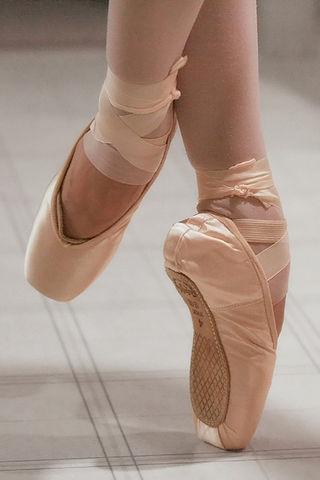
A pointe shoe, also called a ballet shoe, is a type of shoe worn by ballet dancers when performing pointe work. Pointe shoes were conceived in response to the desire for dancers to appear weightless and sylph-like and have evolved to enable dancers to dance en pointe for extended periods of time. They are manufactured in a variety of colors, most commonly in shades of light pink.

A cordwainer is a shoemaker who makes new shoes from new leather. The cordwainer's trade can be contrasted with the cobbler's trade, according to a tradition in Britain that restricted cobblers to repairing shoes. This usage distinction is not universally observed, as the word cobbler is widely used for tradespersons who make or repair shoes.

"The Elves and The Shoemaker" is a set of fairy tales collected by the Brothers Grimm about a poor shoemaker who receives much-needed help from three young helpful elves.

A last is a mechanical form shaped like a human foot. It is used by shoemakers and cordwainers in the manufacture and repair of shoes. Lasts come in many styles and sizes, depending on the exact job they are designed for. Common variations include simple one-size lasts used for repairing soles and heels, custom-purpose mechanized lasts used in modern mass production, and custom-made lasts used in the making of bespoke footwear. Lasts are made of firm materials—hardwoods, cast iron, and high-density plastics—to withstand contact with wetted leather and the strong forces involved in reshaping it. Since the early 19th century, lasts typically come in pairs to match the separate shapes of the right and left feet. The development of an automated lasting machine by the Surinamese-American Jan Ernst Matzeliger in the 1880s was a major development in shoe production, immediately improving quality, halving prices, and eliminating the previous putting-out systems surrounding shoemaking centers.
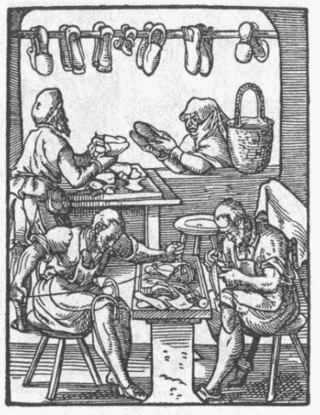
Shoemaking is the process of making footwear.
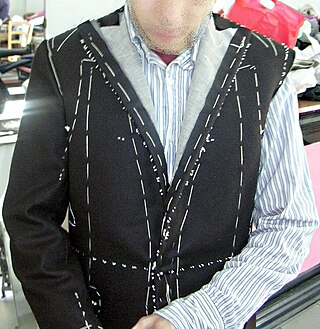
Bespoke tailoring or custom tailoring is clothing made to an individual buyer's specifications by a tailor. Bespoke garments are completely unique and created without the use of a pre-existing pattern, while made to measure uses a standard-sized pattern altered to fit the customer.

Engineer boots, also known as engineer's boots or engineering boots, are an American type of traditional leather work-boots. Their lace-less, rugged construction made them popular among motorcycle riders. Originally developed in the 1930s for firemen working on steam locomotives, the boots gained substantial popularity in the post–World War II era during a growing motorcycling culture. They became popular symbols of teenage rebellion in the 1950s and a common component of greaser wear. They were later adopted by skinheads and punks in the 1970s. By the 2010s, engineer boots were being popularly worn for fashion purposes, especially by non-traditional customers such as women, young urban professionals, and hipsters.

A court shoe or pump is a shoe with a low-cut front, or vamp, with either a shoe buckle or a black bow as ostensible fastening. Deriving from the 17th- and 18th-century dress shoes with shoe buckles, the vamped pump shape emerged in the late 18th century. By the turn of the 19th century, shoe buckles were increasingly replaced by black bows, which has remained the contemporary style for men's formal wear, leather or patent leather evening pumps ever since. This latter style is sometimes also called an opera pump or opera slipper.
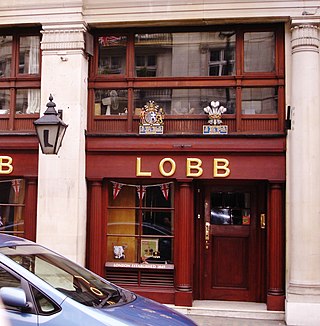
John Lobb Bootmaker is a business that manufactures and retails a luxury brand of shoes and boots, mainly for men but also for women. Leather goods such as wallets and belts are also available. Founded in 1849 by John Lobb (1829–95), the business has been in operation since 1866 in London and circa 1900 in Paris. John Lobb's son William took over the business, and after he died in 1916, the firm was led by Betsy Lobb.
Edward Green is an English shoemaker founded in 1890. Edward Green is based in Northampton, England. The level of handwork involved in production is very high and only around 250 pairs of shoes are completed a week.
"What Men Live By" is a short story written by Russian author Leo Tolstoy in 1885. It is one of the short stories included in his collection What Men Live By, and Other Tales, published in 1885. The compilation also included the written pieces "The Three Questions", "The Coffee-House of Surat", and "How Much Land Does a Man Need?".
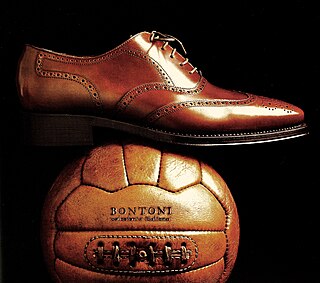
Bontoni is a luxury Italian shoemaker that makes handmade men's dress shoes. Bontoni's nine-person workshop is located on the outskirts of Montegranaro in the Marche Region of Italy.
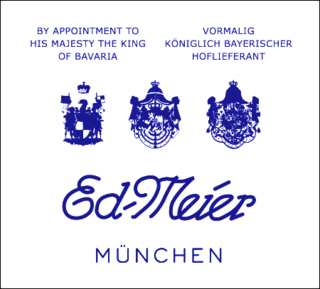
Eduard Meier GmbH is a German shoemaking company. Founded in Munich in 1596, it is the oldest existing shoemaking company in the world. Today, their headquarters and main store are situated at Palais Arco, Brienner Straße 10, in Munich.
Made-to-measure (MTM) typically refers to custom clothing that is cut and sewn using a standard-sized base pattern. Suits and sport coats are the most common garments made-to-measure. The fit of a made-to-measure garment is expected to be superior to that of a ready-to-wear garment because made-to-measure garments are constructed to fit each customer individually based on a few body measurements to customize the pre-existing pattern. Made-to-measure garments always involve some form of standardization in the pattern and manufacturing, whereas bespoke tailoring is entirely made from scratch based on a customer's specifications with far more attention to minute fit details and using multiple fittings during the construction process. All else being equal, a made-to-measure garment will be more expensive than a ready-to-wear garment but cheaper than a bespoke one. "Custom made" most often refers to MTM.

Nike By You is a service provided by Nike allowing customers to personalize and design their own Nike merchandise, most specifically footwear but also sportswear. They offer online services as well as physical studios in different countries around the world, including: United Kingdom, Italy, France, Japan, Spain, Germany, China, USA, Canada and Australia.
Anello & Davide is a footwear company based in Covent Garden, London. It specialises in ballet shoes and theatrical footwear as well as making high quality fashion footwear for men and women. They are perhaps best known as the shoemakers responsible for the Beatle boot. The shop is seen briefly in the opening shot of the 1953 film Street of Shadows.

The word bespoke has evolved from a verb meaning 'to speak for something', to its contemporary usage as an adjective. Originally, the adjective bespoke described tailor-made suits and shoes. Later, it described anything commissioned to a particular specification. In contemporary usage, bespoke has become a general marketing and branding concept implying exclusivity and limited runs.
Veritas Bespoke is a company that manufactures and retails premium leather-soled shoes for men. The brand is founded in 2013 by the Vietnamese Canadian businessman Thanh Le and Thai Nguyen, the professional shoe cobbler in Calgary, Alberta, Canada. Veritas Bespoke has invented a new approach to the traditional shoe-making method: creating bespoke last from 3D scanning technology used in orthopedics footwear. In July 2013, Veritas Bespoke opened its boutique in Calgary. Two years later, Thanh and Nguyen opened their first store in Vietnam at 56 Le Thanh Ton Street, District 1, Ho Chi Minh City
Chris Francis is an American artist, living and working in Los Angeles. Beginning as an artist and carpenter, Francis eventually started creating leather wear worn by Mötley Crüe's Mick Mars, Steve Jones of the Sex Pistols, and former Runaways guitarist Lita Ford. Francis gained acclaim as a high-concept shoe designer creating wearable art.














